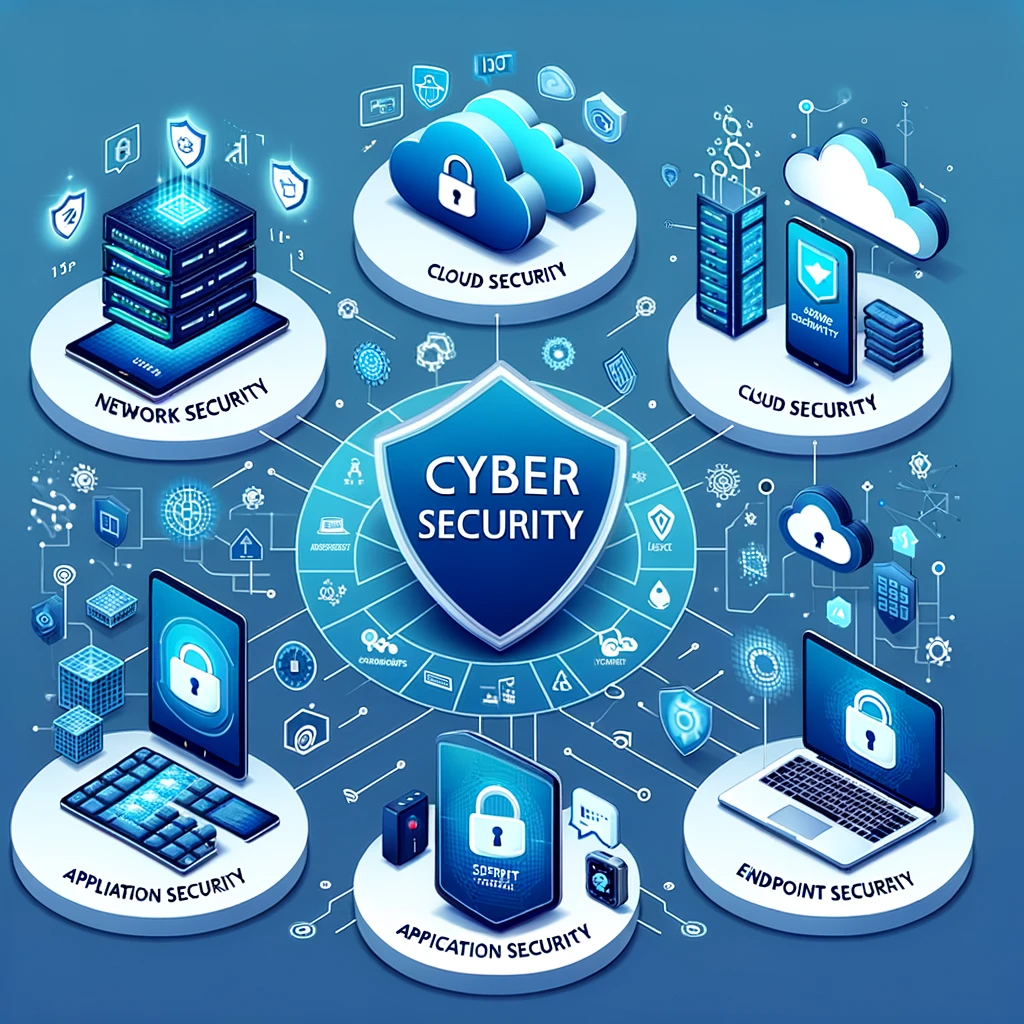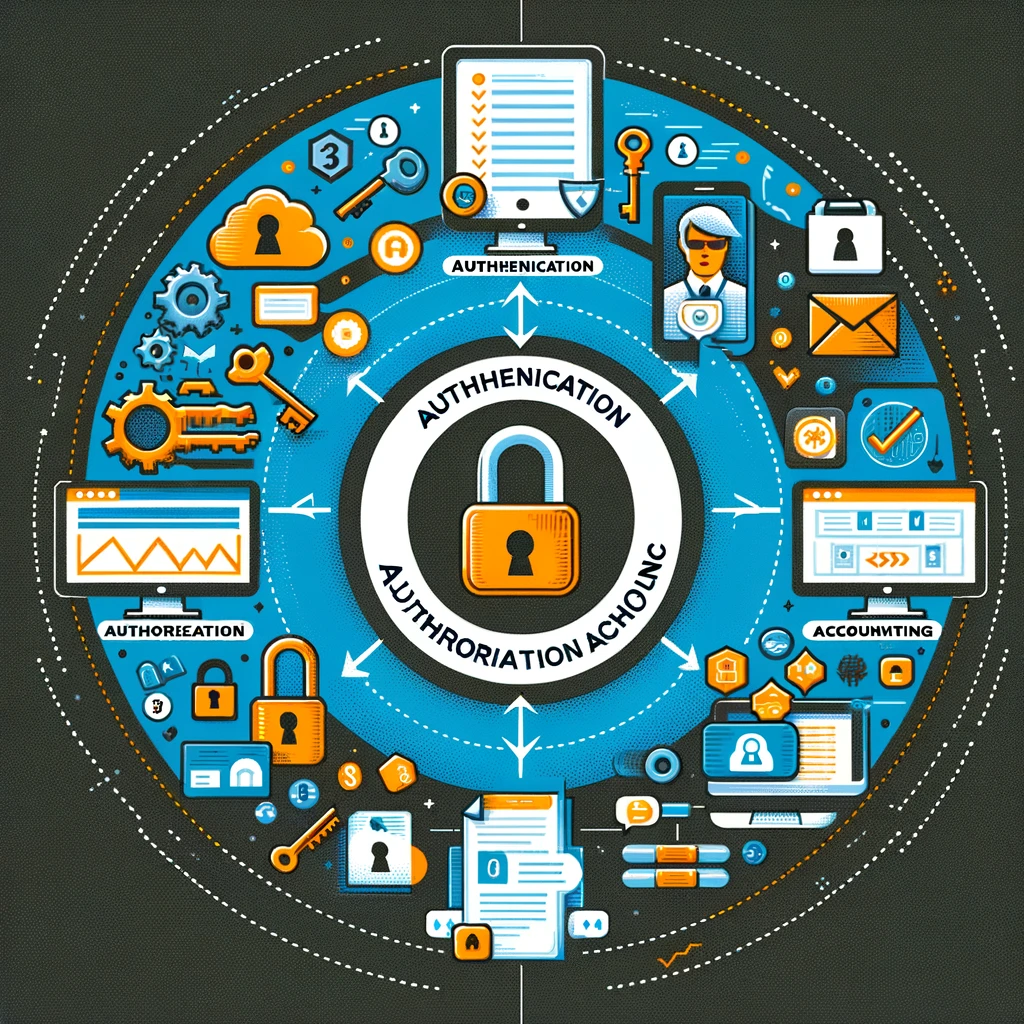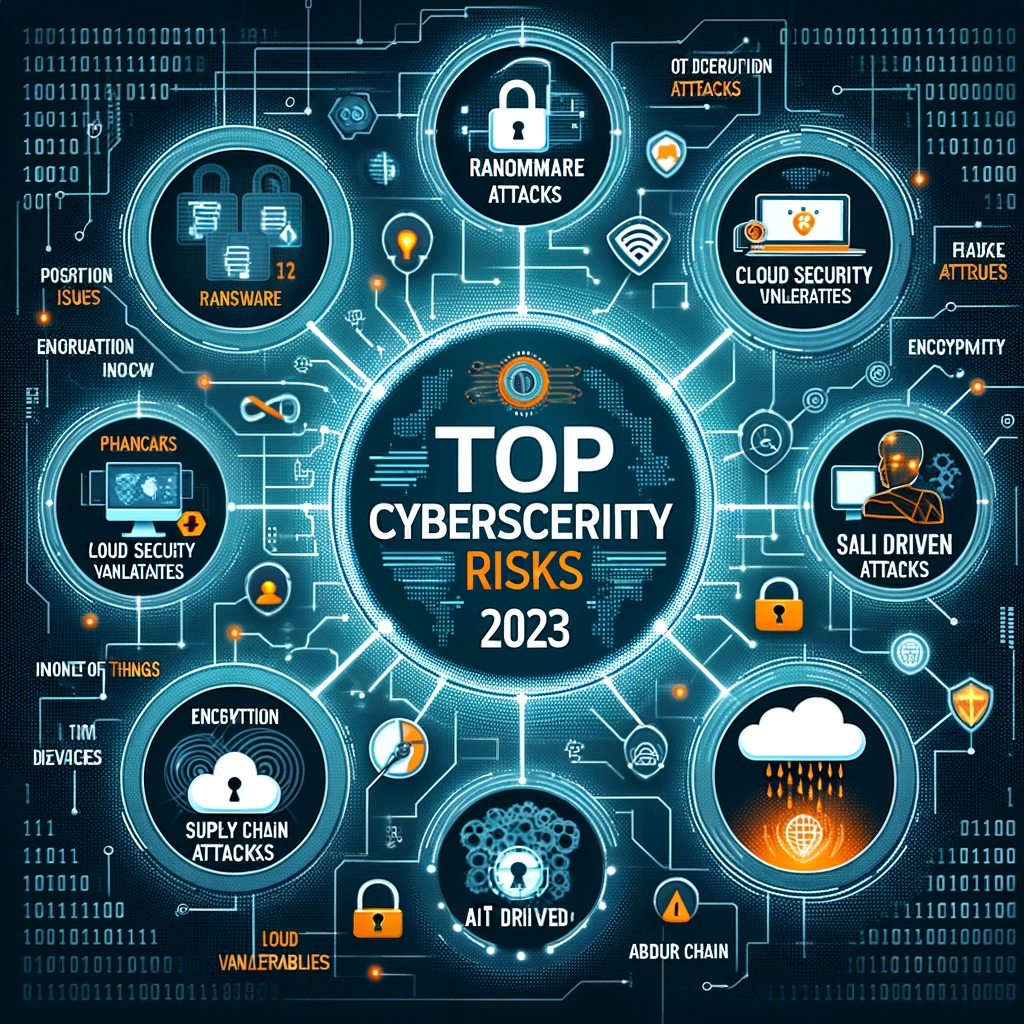Cybersecurity, a vital necessity in our increasingly digital world, encompasses five distinct types, each aimed at ensuring the confidentiality, integrity, and availability of data within an organization. In this article, you can also read our article titled What Is Cybersecurity?These types include:

Application Security: Focuses on protecting software applications from external threats by employing tools like firewalls, antivirus programs, and encryption, along with practices like static code analysis and penetration testing.
Network Security: Involves safeguarding networks and systems from unauthorized access or attacks using methods like firewalls, encryption, antivirus software, and access control mechanisms.
Cloud Security: Ensures the safety of cloud-based systems and data, incorporating strategies like encryption, multi-factor authentication, and regular compliance audits to protect against cloud-based threats.
Critical Infrastructure Security: Protects essential systems such as energy, water, and transportation networks from both cyber and physical threats, employing measures like risk assessments, security awareness training, and physical safeguards.
Internet of Things (IoT) Security: Focuses on securing devices connected to the internet, including home appliances and medical implants, by implementing strong passwords, regular software updates, and vigilant app management.
Each type plays a crucial role in a comprehensive cybersecurity strategy, addressing different areas of vulnerability and safeguarding against sophisticated cyber threats and attacks.
What are the 3 Major Types of Cyber Security?
The three major types of cyber security are crucial in today’s interconnected digital landscape, where businesses and individuals heavily depend on the internet for various activities. These types are:
Application Security: This type involves safeguarding software applications from external threats, especially during their development phase. It employs a range of security measures, including antivirus software, firewalls, and encryption, to prevent unauthorized access and protect sensitive data.
Network Security: Focused on protecting internal networks from hostile intrusions, network security maintains the safety of a network’s infrastructure, restricting access to prevent unauthorized use or modification. Tools like firewalls, antivirus programs, and additional login procedures are employed to strengthen network security.
Cloud Security: As data and services increasingly migrate to cloud platforms, cloud security becomes essential. It involves protecting cloud-based systems using software-based security measures. Cloud security ensures the safety and monitoring of data stored in the cloud, with cloud service providers continually evolving their security features to safeguard enterprise data effectively.
Each of these types plays a vital role in a comprehensive cyber security strategy, addressing different aspects of security to protect against an array of cyber threats.
What is AAA in Security?
AAA in security refers to a framework comprising three critical processes: Authentication, Authorization, and Accounting.
Authentication: This is the initial step, involving user identity verification. Users provide credentials (like passwords, biometric data, or security tokens), which are then compared to a stored database (like Active Directory) to confirm their legitimacy. It ensures that only legitimate users gain access to the network or system.
Authorization: Occurring post-authentication, this process dictates what an authenticated user is permitted to do within a system or network. It involves granting or denying specific privileges to users, based on predefined policies. This process controls the level of access and activities a user can perform, often managed by network administrators.

Accounting: The final step, accounting, involves tracking and recording user activities while they access the network. It logs information such as duration of access, the data transferred, IP addresses, and resources used. This process is crucial for auditing, monitoring resource usage, and in some cases, billing purposes.
Together, these components of AAA provide a comprehensive approach to network security, managing user access, enforcing policies, and monitoring the use of resources. AAA is integral to cybersecurity, ensuring that only authenticated users have access to specific resources and that their activities are tracked for security, compliance, and operational efficiency. This framework is essential in modern network management and plays a significant role in safeguarding sensitive information and systems.
What is the CIA in Cyber Security?
The CIA in cybersecurity refers to the three fundamental principles of information security: Confidentiality, Integrity, and Availability.
Confidentiality: This involves protecting sensitive information from unauthorized access and disclosure. It ensures that data is accessible only to those with the right authorization, thereby safeguarding privacy and sensitive information.
Integrity: Integrity pertains to maintaining the accuracy and reliability of data. It ensures that information is not altered or tampered with by unauthorized individuals, thereby preserving the correctness of the data.
Availability: Availability ensures that data and resources are accessible to authorized users when needed. It focuses on making sure that systems, networks, and data are available to users and are not hindered by attacks or technical issues.
Together, these principles form the CIA Triad, a cornerstone of cybersecurity, guiding the development and implementation of effective information security policies and controls. This model is critical for understanding and addressing various aspects of IT security, aiming to minimize threats to these essential components.
How Do I Become a Cybersecurity Engineer?
To become a cybersecurity engineer, typically a bachelor’s degree in computer science, cybersecurity, or a related field is required, taking about four years. You can also look at our article titled What is Social Engineering in Cybersecurity, where we explain what social engineering is. Practical experience is also crucial, gained through internships or entry-level positions. Cybersecurity engineers design and manage secure solutions against cyber threats, requiring proficiency in programming languages like C++, Java, or Python.
Essential skills include problem-solving, detailed knowledge of firewalls, endpoint security, and staying current with cybersecurity trends. Experience in incident detection, response, and forensics is beneficial. Certifications like CompTIA Security+ and Certified Ethical Hacker can enhance job prospects. With growing internet reliance, demand for cybersecurity engineers is increasing, offering promising career opportunities.
What are the Top Cybersecurity Risks 2023?
In 2023, the cybersecurity landscape faces a multitude of evolving threats, demanding heightened vigilance. Key risks include:
Sophisticated Phishing and Social Engineering Attacks: Hackers are leveraging advanced tactics, exploiting human vulnerabilities rather than technical loopholes, making them increasingly dangerous and prevalent.

Ransomware Evolution: These costly attacks hold data hostage, with payment demands often made in untraceable cryptocurrencies. Ransomware’s sophistication is rising, targeting not just organizations but high-net-worth individuals.
Cloud Vulnerabilities: Despite advancements in cloud security, risks persist due to misconfigurations, poor access control, and shared tenancy issues. Organizations must balance the benefits of cloud storage with its inherent security challenges.
Cyber-Physical System Threats: As infrastructure becomes more interconnected, the risk of cyberattacks disrupting critical systems like power grids and transportation networks grows.
State-Sponsored Cyberattacks: These politically motivated attacks target government and private sector systems, intensifying concerns over national and global cyber warfare.
IoT Device Security: The proliferation of connected devices increases vulnerability points, exposing both individuals and businesses to potential cyber invasions.
Mobile Device Attacks: With the rise of mobile usage, smartphones become prime targets for cyber threats, including spyware and malicious apps.
Data Breaches: High-profile breaches continue, compromising sensitive personal and corporate data, a trend that shows no signs of abating.
Third-Party Exposures: Outsourcing and supply chain dependencies expose organizations to additional risks, as third-party vulnerabilities can be exploited by cybercriminals to access protected systems.
Remote Work Security Challenges: The shift to remote work environments has exposed new vulnerabilities, such as insecure Wi-Fi networks and the use of personal devices for work purposes.
Machine Learning and AI in Cyberattacks: The use of advanced technologies by cybercriminals enables more efficient and targeted attacks, outpacing traditional defense mechanisms.
Cryptojacking: The unauthorized use of someone else’s computing resources to mine cryptocurrency, highlighting the need for robust system monitoring.
Shortage of Cybersecurity Professionals: A significant gap in skilled cybersecurity personnel leaves organizations vulnerable and unable to adequately respond to threats.
Emerging Technologies and New Platforms: Rapid technological advancements create new vulnerabilities, particularly in areas like 5G networks and blockchain technology.
Regulatory Compliance and Privacy Concerns: Navigating evolving privacy laws and compliance requirements adds complexity to cybersecurity management.
These risks underscore the need for robust cybersecurity strategies, encompassing technological solutions, employee training, and awareness, along with proactive monitoring and response plans to effectively combat and mitigate these evolving cyber threats.










